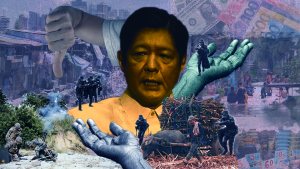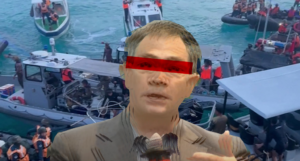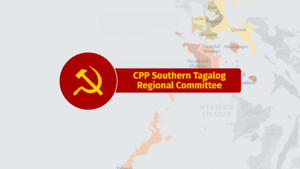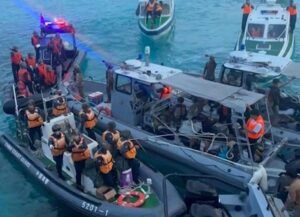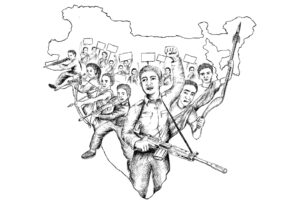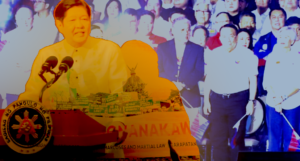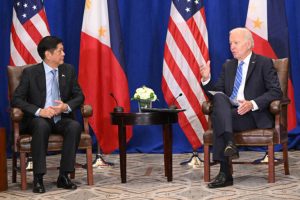Response to questions from the Washington Post
In the opinion of the CPP, why did the peace talks with Duterte breakdown?
The immediate reason leading to the breakdown of the NDFP-GRP peace negotiations
was Duterte’s adamant demand that the NDFP enter into a long-term bilateral
ceasefire agreement even before agreements on socio-economic reforms and
political and constitutional reforms are signed.
The NDFP rightfully refused such a demand, as it is inconsistent with the ground
rules and agenda set forth in the 1992 Hague Declaration which both parties
agreed to uphold. According to The Hague Declaration, the cessation of
hostilities is to be the last in the four-item agenda of the talks. However, the
NDFP exercised flexibility by proposing that a bilateral ceasefire agreement can
be signed immediately following the signing of the comprehensive agreement on
socio-economic reforms (CASER). In fact, this was among the items that were set
to be discussed in the fifth round of talks scheduled last November.
Duterte, however, would have none of it. Just as the negotiating panels of both
sides were coming together in Oslo, Norway, he issued Proclamation 360 last
November, declaring the termination of NDFP-GRP peace negotiations in complete
disregard to the agreed processes and the facilitation of the Royal Norweigian
Government. A few weeks later, Duterte would issue another proclamation
proscribing the CPP and NPA as “terrorist organizations” under the Human
Security Act.
In a broader sense, it can be said that the breakdown of the NDFP-GRP peace
talks is a result of the continuing predominance of the counter-insurgency
doctrine of the US government which the Armed Forces of the Philippines (AFP)
religiously adheres to and pursues. Such doctrine considers peace negotiations
as merely a method to induce the surrender of revolutionary forces in the
context of waging a war of suppression to crush the people’s armed resistance.
Does the CPP wish to resume talks? Under what circumstances?
Yes, the CPP hopes to see the resumption of NDFP-GRP peace negotiations. The
revolutionary forces consider peace negotiations as an additional means of
resolving the pressing socio-economic problems of the people. Peace talks can
resume if the Duterte regime, or any succeeding regime, will drop the framework
of using peace negotiations merely to cause the surrender of the NPA and instead
engage in peace talks to seriously address the roots of the armed conflict.
Specifically, the Philippine government must abide by its commitment under The
Hague Declaration and stop prematurely demanding the NDFP to enter a long-term
ceasefire agreement.
Broad sections of Philippine society clamor for the Duterte regime to respect
human rights in the course of conducting its Oplan Kapayapaan war of
suppression. It does not bode well for the NDFP-GRP peace talks that Duterte
repeatedly issues declarations in complete contempt of human rights and
international humanitarian law and order the GRP’s police and armed forces to
carry out acts which violate the Comprehensive Agreement on Respect for Human
Rights and International Humanitarian Law (CARHRIHL). The CARHRIHL, signed 20
years ago, is the first substantive agreement signed between the NDFP and GRP.
3. What has been the effect of martial law in the regions where NPA operates in
Mindanao?
Since martial law was declared in Mindanao, the AFP and its paramilitaries have
unleashed a brutal war of suppression mainly against civilians in areas which
the AFP consider as part of the mass base of the NPA. Several battalions of
soldiers have been deployed to occupy rural villages, targetting local peasant
leaders and peasant organizations. In less than ten months, more than 120
peasant leaders have been killed across Mindanao. The AFP has mounted aerial
bombardment campaigns and threatened people that their communities will become a
mini-Marawi (referring to the five-month bombardment and total destruction of
Marawi City). Around 30,000 people across Mindanao have been forced to evacuate
as a result of threats of bombardment and actual aerial bombing in North
Cotabato, Bukidnon, Davao del Sur, Compostela Valley, the Surigao and Agusan
provinces in Caraga and other provinces. The AFP has imposed curfews as well as
food and aid blockades. It has restricted people’s movements requiring local
residents to sign logbooks.
The AFP has mounted a so-called “surrender campaign” where residents of rural
villages are compelled to attend meetings and made to sign blank sheets of
paper, which are later presented as surrender documents. They are paraded before
the media as “surrenderees.” Recently, the AFP claimed there are 4,300 “NPA
surrenderees,” although it had recently declared that there are merely 3,700
members of the NPA.
How many active NPA cadres are there in the Philippines? In Mindanao?
The CPP does not release exact numbers of NPA members to keep the AFP in the
dark about the NPA’s actual strength. It can be said, however, that the NPA
operates in more than 100 guerrilla fronts, divided into 13 regions nationwide
covering more than 80% of all provinces.
In its statements, the Party has declared that the NPA is about to surpass its
peak strength in the late 1980s.
What does the NPA currently do in the areas it controls, for example in Caraga?
What are its daily activities, what does it do either for the people in the
region or in order to further its goals?
Wherever the NPA operates, it carries out the following: (a) campaigns to
implement the minimum program of land reform to reduce feudal land rent,
interest rates, irrigation fees, and rent of work animals and farm equipment, to
raise farm wages, improve farm gate prices of crops for the benefit of peasants,
and to raise peasant income by raising agricultural production through different
forms of cooperation or improving or supporting sideline occupation; (b)
organizing the people in mass organizations of peasants, women and youth as
foundation for building the organs of governance, to carry out programs to
address the needs of communities including crop production for consumption,
literacy and education, peace and order, medical missions, mediation and
resolving conflicts, dispensing justice and so on; and (c) conducting extensive
and intensive guerrilla warfare by launching tactical offensives against enemy
military targets.
The NPA implements various policies of the people’s government including those
pertaining to environmental protection, especially those prohibiting big
plunderous commercial logging and mining operations which cause widespread
destruction.
Particular in Caraga, the NPA have been active in defending the Lumad and their
communities against mining activities of Nickel Asia, Taganito and other foreign
big companies for decades.
6. Is it true that NPA still conducts revolutionary trials and executions in its
territory?
The people’s government implements a justice system that favor the interests of
the democratic classes and sectors. The guide to establishing the people’s
courts helps the organs of political power or provisional revolutionary
government at the barrio level up in dispensing justice. There is system of
mediation for non-antagonistic conflicts among the people. In criminal cases,
there is a system of people’s courts and trials. A revolutionary penal code is
being developed to codify the system of punishment.
As the standing army of the provisional government, the NPA is tasked to carry
out convictions which can range from village arrest, exile, confiscation of
property. Capital punishment is meted against those convicted of capital crimes.
The justice system covers individuals, as well as companies which operate within
the territories of the revolutionary government.
7. What kind of final outcome would CPP-NPA like to see after successful peace
talks? A solution like they reached in Colombia? Something more like the
Naxalites have? How might you describe an ideal scenario under which peace can
flourish?
The desired final outcome of the peace process is spelled out in the 1992 The
Hague Declaration which details the agenda and succession of reforms and
programs. This include socio-economic reforms, particularly national
industrialization and land reform, and political and constitutional reforms for
the benefit the people. These reforms should be mutually agreed upon by both
parties and carried out judiciously to give way to the cessation of hostilities
and thereafter, ending the decades-long armed conflict. So far, the NDFP has
drafted an agreement for socio-economic reforms and should’ve been subjected to
negotiations last November if the Duterte regime did not terminate the talks.
The ideal scenario for the talks to prosper is if the current government and
other successive governments honor previous agreements. This include the agenda
and succession of the talks, immunity and security for the negotiators and
respect for human rights and international rules of war to govern the conduct of
the armed conflict. The talks can continue even amidst the fighting. All changes
and scenarios can be discussed and mutually agreed upon. All it takes for the
negotiating government is to show sincerity in resolving the root causes of the
war and refrain from using the talks for pacification and capitulation of the
revolutionary forces.
There lies the basic difference with the Colombian and Philippine peace process.
Cessation of hostilities and laying down of arms will only commence once the
substantive agenda for socio-economic and political reforms are signed and
initially implemented.

